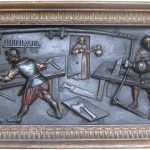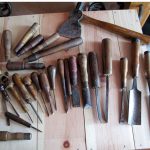We may receive a commission when you use our affiliate links. However, this does not impact our recommendations.
It’s fairly uncommon to find old workbenches in the wild that don’t have stretchers below the benchtop. After all, it’s quite handy to have a shelf down there for planes, other tools and furniture parts. So even if a workbench started life as a Roman-style bench without stretchers, I think there’s a fair chance that some owner of the bench would add stretchers at some point.
One of the most famous workbenches in this stretcher-less style is the one shown in the Stent panel, an interesting carving of the interior of a joinery and turning shop in the 17th century.
The Stent panel features benches that look a bit French, yet they don’t have any stretchers between the legs. Benches without stretchers are generally very early examples.
So I was quite pleased when Frank Ederveen sent me some photos of a workbench he spotted in a London auction house this week. Its label says it’s a 19th-century elm workbench. But I have no way of knowing how accurate that description is.
There are some curious features to this workbench that bear mentioning for woodworkers out there who are designing a traditional bench.
1. The stretchers on the ends are only notched and pegged into the legs – not mortised. They could have been a later addition.
2. Three of the legs pierce the top with a single through-tenon. The leg at the face vise pierces the top with a much larger tenon plus a sliding dovetail a la Roubo.
3. The planing stop is notched at the front and appears to have four nails protruding from the stop to help hold your work. Frank wasn’t able to raise the planing stop any higher to see if the nails were driven all the way through the stop. In any case, it’s a smart and workman-like solution to adding holding power to a traditional stop.
4. Overall, the bench is 215.5 cm (85”) long, 41.5 cm (16-3/8”) deep and 77 cm (30-1/4”) high.
After inspecting about 40 photos of the bench that Frank took on his lunch hour (thanks Frank!), I’m impressed with the overall workmanship of the bench and some of the details that appear to be quite early.
I can’t say how old this bench is, but I do think it would look at home in the Stent panel.
— Christopher Schwarz
Want to read more about early woodworker and joinery? Take a deep dive with “Make a Joint Stool from a Tree” by Jennie Alexander and Peter Follansbee. This isn’t just a book about building a joint stool. It’s an exploration of early joinery. And it is a liberating document for anyone trying to build furniture with a limited tool kit. Highly recommended.
Here are some supplies and tools we find essential in our everyday work around the shop. We may receive a commission from sales referred by our links; however, we have carefully selected these products for their usefulness and quality.


















That guy wearing armor must be as accident-prone as I am…
The rust staining on top of the bench stop provide evidence of how they’d be installed, as they would normally be driven squarely into pilot holes within the stop from the front and “enhanced” once in place.
My favorite part of the panel is the nice lady bearing beverage.